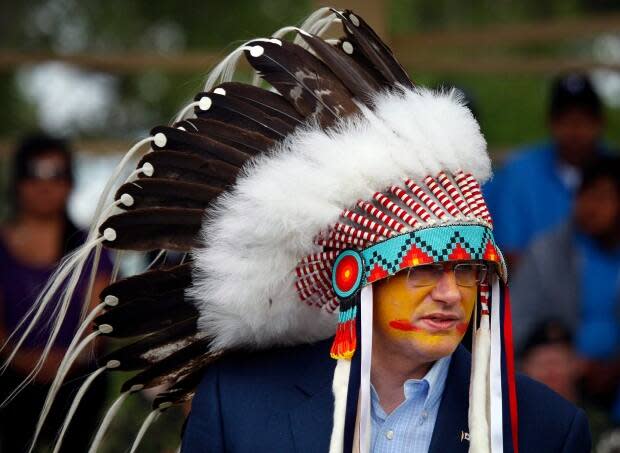5 times non-Indigenous dignitaries donned gifted headdresses

When Wilton Littlechild, honorary chief of Ermineskin First Nation, gifted Pope Francis a headdress on Monday in Maskwacis, Alta., there was a smattering of applause at the event but online it drew a wave of reaction from the Indigenous community.
"People have started to say that the headdress doesn't mean anything anymore, that it's been tainted — tainted by politicians and people who just give it to anybody," said Kevin Tacan, a spiritual advisor for the Sioux Valley Dakota Nation told CBC Manitoba.
Former Assembly of First Nations National Chief Phil Fontaine has defended the decision, saying Littlechild "went to the elders. He went to the leadership and requested permission to present that gift. So [it was] entirely consistent with the way they followed their customs and protocol."
This isn't the first time prominent non-Indigenous figures have been given this symbol of leadership. In fact, Pope John Paul II received an honorary chief's title from the Blood Tribe. Here are some other examples.
Alberta Premier Rachel Notley

Rachel Notley received a traditional Blackfoot name and was gifted a headdress during the International Peace Powwow in 2019.
Notley received the name of Braveheart Woman from an elder in Lethbridge. Notley later said about the honour, "I think mostly I walk away just being incredibly grateful and humbled to be given such an amazing name and I know there are some days when you have to go into what you do with that approach."
Despite some negative reaction on social media, the person who made the decision to present the headdress said at the time she had no regrets.
"I can be really facetious.. [but] the only one that has the right to complain about this headdress is the eagle. And he's not complaining," Mary Ann Crow Healy told CBC Indigenous.
Prime Minister Justin Trudeau

Justin Trudeau was given a headdress and a traditional name during a 2016 ceremony by the Tsuut'ina Nation near Calgary, alongside then-Assembly of First Nations National Chief Perry Bellegarde, for his commitment to Indigenous issues.
Trudeau was bestowed the name Gumistiyi, which translates to "the one that keeps trying," by elders in the community.
One of the key issues that the Tsuut'ina Nation decided to honour him for was for starting the national inquiry into missing and murdered Indigenous women and girls.
Prime Minister Stephen Harper

The Blood Tribe in Alberta honoured Stephen Harper in 2011 with a headdress, the traditional name of Chief Speaker and an honorary chief title.
At the time, Chief Charles Weasel Head said the name was chosen because Harper "speaks as the chief. His words are words that come from his position."
The decision by the tribe to bestow the honours was made after Harper's 2008 apology for residential schools.
Prince Charles
In the summer of 1977, Prince Charles was honoured by the Blood Tribe as an honorary chief. The ceremony took place in a sundance arbour in Treaty 7 territory.
In 1979, the National Film Board released a short documentary about the event, A Pinto for the Prince.
Prime Minister John Diefenbaker

John Diefenbaker attended a ceremony in 1959 to celebrate the beginning of construction on the Gardiner Dam, near Outlook, Sask. Whitecap Dakota First Nation Chief Harry Littlecrow gifted a headdress to Diefenbaker, made him an honorary chief and gave him the name Tatanka Mani (Walking Buffalo).
A replica of the headdress was made by the First Nation to display at the Diefenbaker Canada Centre on the University of Saskatchewan campus in Saskatoon.
Long list
Others who have received such honours include Prime Minister Lester Pearson, Prime Minister Jean Chretien, former governor general Adrienne Clarkson, Alberta premiers Peter Lougheed and Ralph Klein, environmentalist David Suzuki, then-Husky Energy president John Lau and ATCO president Nancy Southern.


